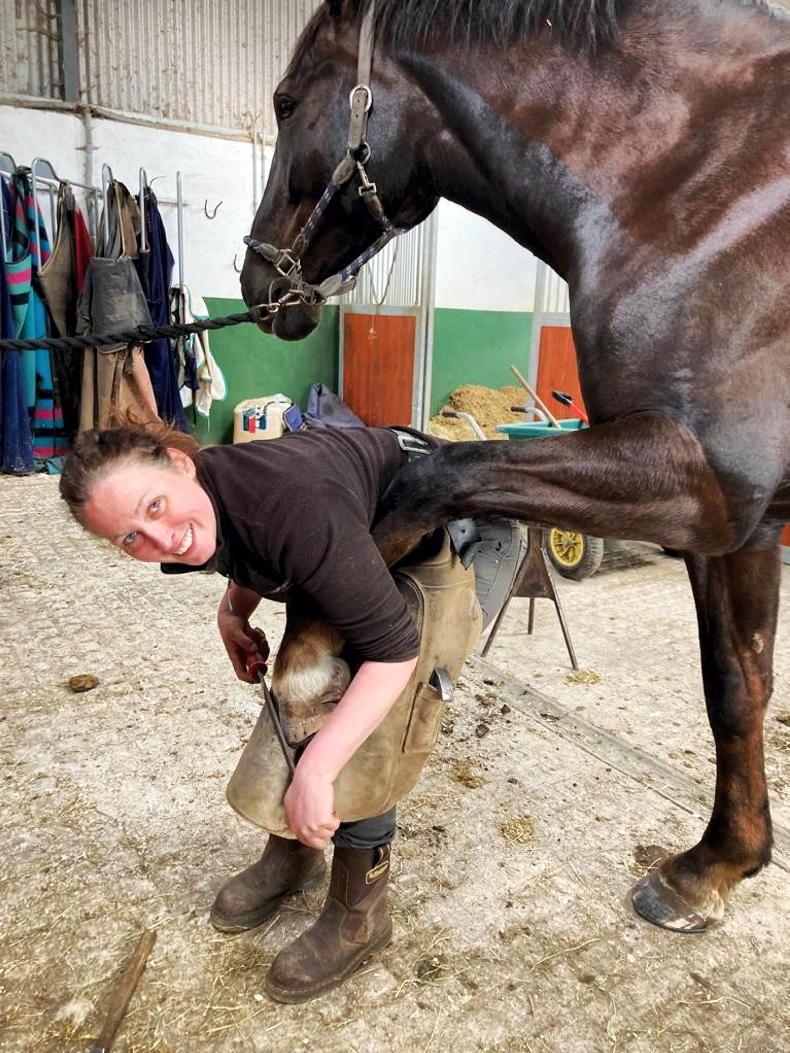There is actually another fully qualified female farrier in Galway named Shauna Murray Freeney,” says Sarah.
“I’m delighted to say that there are at least two female apprentices in the system too. I am extremely proud of my qualifications and to be an active member of the Irish Master Farriers association.”
Sarah is currently serving as secretary and auditor of the European Federation of Farriers Association, and readily admits: “I am proud to have the respect from my peers.
"Thankfully since I trained 20 years ago attitudes have changed and there are now so many inspirational women in all areas of the equine industry.
"I always aspire to be a good role model for young women and hope I’ve helped pave the way for them.”
The daily toil of the heavy graft of farriery often means that farriers have an unenviable set of aches and pains, and many can be ultimately career ending.
Sarah hasn’t had it too tough so far, but has a feeling there’s body trouble in the post: “I have to admit I don’t exercise or do yoga or pilates.
"I keep myself fit for the job by doing it; if I have time off, I’ll feel it for a couple of days when I start back.
"I’ve been extremely lucky that my body has stood up to the physical demands of the job; but I’m sure I’ve got a hip, knee or elbow replacement surgery to look forward to in the future.”
Tools of the trade
A farrier’s tools are as vital as any surgeon’s, and like anyone who has honed their craft, there are tools in their arsenal that are priceless to them.
“My clenching block is invaluable. I’ve had it since I first started and I’ve never been able to find another the same.
"I lost it for a week once and had to use another; I got tennis elbow so badly I was in tears, but thankfully it turned up and my elbow stopped complaining!”
Raised in the Isle of Man and obtaining excellent grades at school, Sarah left the island at 16 and enrolled at Moreton Morrell Agricultural College in the UK to undertake a pre-farriery course.
On completion she returned to the Isle of Man and had the good fortune to be put in contact with Master Farrier John Dooley from Kildare.
Two week trial
“John agreed to give me a two week trial. It must have gone well as he took me on as his apprentice and put up with me for nearly five years, which I will be forever grateful for.
"Unfortunately the farriery school in Ireland hadn’t yet opened, so I enrolled to the Worshipful Company of Farriers in the UK to do the DipWCF. All my college training blocks and exams took place over there.”
As any equine vet, dentist or other professional who works with horses all day every day will tell you, it can be exhausting and dangerous work and can colour how you view them.
Make sure your horse is safe for farriers to work under by taking the time to handle young, nervous or unhandled horses before the farrier comes
Sarah admits that her relationship with horses has changed, but not for the worse: “I think about horses in a different way now.
"Working with them for 20 years has given me more understanding and respect for them, rather than my youthful romanticised thinking.”
And so what can we do to help our farriers? Sarah gives me the low down on what as horse owners we can do to support them in their work.
“We need the horses to have clean dry feet and we need decent work space because wet conditions and muck blunt our tools.
Make sure your horse is safe for farriers to work under by taking the time to handle young, nervous or unhandled horses before the farrier comes.
"Be honest at the start if your horse has issues so we know what we’re dealing with before we get under them.
“Keeping the feet regularly done by a qualified farrier is also important. Most issues are caused by leaving it too long between farrier visits. Regular visits means you can get on top of any problems quickly to avoid those becoming major issues.”
Lessons learned
With horses there are infinite mysteries and a life-time of things to learn no matter what level of involvement you have with them. We always remember the horses that taught us new things.
One horse that stuck in Sarah’s mind during her 20 years was a mare named Lilly. “She was shod religiously every six weeks; perfect healthy feet. At one point she was shod as usual but just six weeks later I went to re-shoe her and in that short time she had developed white line disease.”
White line disease is a serious condition which if left unchecked, can eat so far up the hoof wall that it becomes completely unstable. The white line is seen on the underside of the foot where the unpigmented horn of the inner hoof wall joins the horn of the sole.
Degeneration of the horn at the white line leads to separation of the hoof wall from the underlying structures and weakening of the hoof wall.
“It had travelled extensively around the outside of her foot almost to the coronary band. I couldn’t believe how quickly it happened and how quickly the hoof recovered, within six months of treatment and remedial shoeing the foot was perfect again. It’s a tough job but very rewarding.”
